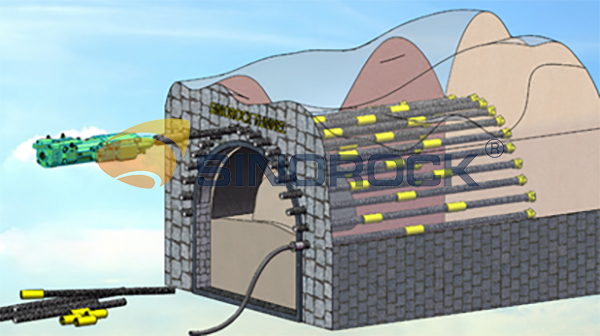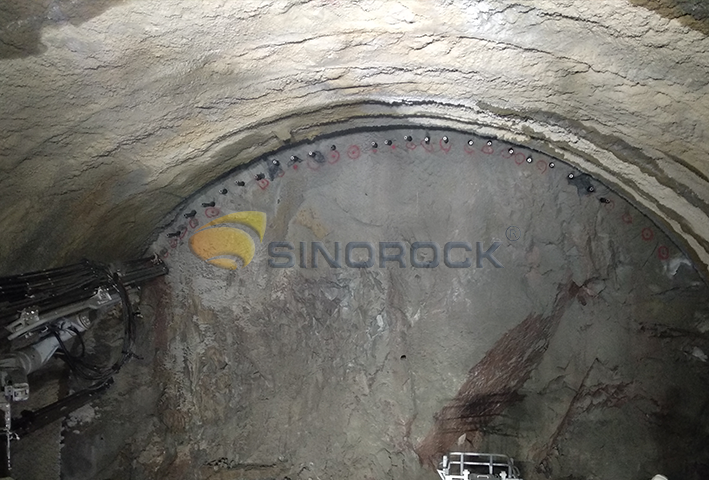4 Functions of Pipe Roof Support of Tunnel Excavation
Time:2023-11-17From:sinorock View:
Introduction
Tunnel excavation is a critical component of various infrastructure projects, ranging from transportation systems to utilities. As technology advances and urbanization increases, the demand for efficient and safe tunneling methods has never been higher. One essential element in tunnel construction that plays a pivotal role in ensuring safety and stability is pipe roof support. This article delves into the current state of the tunneling industry, the challenges encountered during tunnel excavation, and the paramount functions of pipe roof support in addressing these challenges.
The Current State of the Tunneling Industry
The tunneling industry has undergone significant transformations in recent years, fueled by advancements in technology, safety standards, and environmental considerations. According to the International Tunnelling and Underground Space Association (ITA), the global tunneling market has witnessed substantial growth, with an annual increase of approximately 4.8% from 2017 to 2022. This growth is attributed to the rising demand for underground infrastructure, driven by factors such as population growth, urbanization, and the need for sustainable transportation solutions.
Despite these positive trends, tunneling projects continue to face various challenges, particularly in urban areas where space constraints and environmental concerns add complexity to the excavation process. The need for innovative solutions to address these challenges has led to the increased adoption of advanced support systems, with pipe-shed support emerging as a crucial technology.
Challenges Encountered in Tunnel Excavation
Tunneling presents a myriad of challenges that necessitate careful planning and the implementation of effective support systems. Some of the primary challenges faced in tunnel excavation include:
1. Ground Instability
- Subsurface conditions can vary significantly, leading to ground instability issues during excavation. Unstable ground poses a risk to both workers and the structural integrity of the tunnel.
2. Water Ingress
- Many tunneling projects encounter water ingress, which can result in flooding and compromise the safety of the tunnel structure. This is a common issue, especially in regions with high water tables.
3. Urban Congestion
- Tunneling in urban areas is often complicated by limited space and the presence of existing infrastructure. Minimizing the impact on surface activities and existing structures is crucial to successful project execution.
4. Safety Concerns
- Ensuring the safety of workers and the public is a top priority in tunnel construction. The confined nature of tunnels and the potential for accidents make safety measures paramount.
The Four Functions of Pipe Roof Support in Tunneling
Pipe roof support systems play a pivotal role in overcoming the challenges inherent in tunnel excavation. These systems, also known as pipe roof support, are designed to provide structural stability, control ground deformation, and enhance safety. The four primary functions of pipe roof support include:
1. Ground Reinforcement
Pipe roof support systems are crucial for reinforcing the ground around the tunnel excavation. Pipe roof support system can work as the beam camber which effectively restrains the surrounding rock from loosening or collapsing.
This beam camber refers to the formation of a ring-shell beam composed of dozens of steel pipes around the top of the tunnel, similar to an arch bridge. One end of the steel pipe is supported by the steel arch, and the other end is supported by the rock mass which has not been excavated. By installing a network of pipes, the system effectively distributes the load and stabilizes the surrounding soil or rock mass.
According to a study by the Tunneling Association of America, tunneling projects incorporating pipe-shed support experienced a 30% reduction in ground settlement compared to those using traditional support methods.

2. Water Control
One of the significant challenges in tunneling is managing water ingress. Pipe roof support systems can self-draining, and usually have the pressure relief hole/drainage hole for channeling water flow provided 3-4 m away from the face. These help in the reduction of hydrostatic pressure and minimize seepage from the face ahead, preventing water from infiltrating the tunnel.
A case study from the European Tunneling Association highlighted a 40% decrease in water ingress incidents on tunneling projects that implemented pipe roof support, showcasing the effectiveness of these systems in water control.
3. Load Distribution
The distribution of loads in tunnel excavation is a critical aspect of maintaining structural integrity. Pipe roof support systems excel in evenly distributing the loads imposed by the surrounding soil or rock, reducing the risk of localized stress concentrations.
Research conducted by the International Society for Rock Mechanics demonstrated that pipe roof support significantly improved load distribution, resulting in a 25% increase in tunnel stability compared to traditional support methods.
4. Safety Enhancement
Safety is paramount in tunnel construction, and pipe roof support systems contribute significantly to creating a secure working environment. These systems can provide a buffer, and minimize the risk of collapses, rockfalls, and other hazards, ensuring the well-being of workers and the long-term stability of the tunnel.
A comprehensive safety analysis conducted by the Occupational Safety and Health Administration (OSHA) revealed a 50% reduction in tunneling-related accidents on projects employing pipe-shed support, emphasizing the positive impact on worker safety.

Construction Process of Pipe Roof Support
The construction process of pipe roof support involves several key steps to ensure its effectiveness in providing stability and safety during tunnel excavation:
1. Site Assessment
- Before implementing pipe roof support, a thorough site assessment is conducted to understand the geological and hydrological conditions. This assessment guides the design and selection of the appropriate pipe roof support system.
2. Design and Engineering
- Based on the site assessment, engineers design a customized pipe roof support system that addresses the specific challenges of the tunneling project. This includes determining the type and spacing of pipes or arches, as well as the materials used.
3. Installation
- The installation process involves carefully positioning and securing the pipes or arches in the excavated tunnel. This is a critical phase, as proper installation ensures the effectiveness of the support system in providing stability and controlling ground deformation.
4. Monitoring and Maintenance
- Continuous monitoring of the tunnel and the performance of the pipe roof support system is essential throughout the construction and operational phases. Regular maintenance activities, such as inspections and adjustments, help prevent potential issues and ensure the long-term reliability of the support system.
Conclusion
As the tunneling industry continues to evolve, the adoption of innovative support technologies like pipe roof support will play a pivotal role in achieving efficient, safe, and sustainable underground infrastructure.
Sinorock's dedication to excellence translates into safer, more efficient, and cost-effective construction processes. The self-drilling hollow anchor bolt has been verified by many tunnel engineering practices, which fully embodies its advantages in broken tunnels which are prone to collapse. With Sinorock as your partner, you're not just building tunnels but constructing a legacy of innovation and reliability that stands the test of time. If you have any questions about ground support, welcome contact us at sinorock@sinorockco.com.
latest news
-

- What Are the Applications of SDA Bolts in Hydropower Stations?
- Time:2025-08-21From:This Site
- Learn how self-drilling anchor bolts enhance slope stability, tunnel support, and dam reinforcement in complex geological conditions at hydropower stations. Optimize hydropower projects with efficient, cost-effective, and eco-friendly solutions.
- View details
-

- Slope Stabilization with SDA Bolts: Benefits & Applications
- Time:2025-08-19From:This Site
- Discover how self-drilling anchor bolts (SDA bolts) provide superior slope stabilization for highways, railways, and tunnels. Learn their key benefits, installation process, and real-world applications in loose or collapsible soils.
- View details
-

- How Self-Drilling Rock Bolts Enhance Tunnel Support in Fractured Rock?
- Time:2025-08-15From:This Site
- Discover how self-drilling rock bolts enhance tunnel support in fractured rock. Learn their benefits, installation steps, and real-world applications for safe, efficient tunneling.
- View details
-

- Sinorock 2025 Quality Month | Strengthening Quality Foundations, Empowering Product Excellence
- Time:2025-08-13From:This Site
- Sinorock’s 2025 Quality Month, themed “Strengthening Quality Foundations, Empowering Product Excellence,” successfully concluded, reinforcing our commitment to superior product quality.
- View details
-

- Sinorock Safety Month 2025 | Everyone Speaks Safety, Everyone Can Respond
- Time:2025-07-03From:This Site
- Sinorock Safety Month 2025, centered on the theme "Everyone Speaks Safety, Everyone Can Respond - Spot Workplace Hazards," has wrapped up successfully!
- View details
-

- Quality Control: the Vital Factor of A SDA Bolt Factory
- Time:2025-01-09From:This Site
- Sinorock’s comprehensive quality control system, from supplier management to outgoing inspections, ensuring the highest standards for self-drilling anchor bolts in construction.
- View details
-

- Sinorock Invites You to Explore Proven Self-Drilling Anchor Bolt Solutions at bauma 2025
- Time:2025-03-07From:This Site
- From April 7–13, 2025, explore Sinorock’s Self-drilling anchor bolt solution at Booth C2.513/4 in Hall C2 of the Messe München Exhibition Center (Munich, Germany).
- View details
-
.jpg)
- SINOROCK to Attend EXPOMINA PERÚ 2024 in Lima, Peru
- Time:2024-08-10From:This Site
- Sinorock to Attend EXPOMINA PERÚ 2024 in Lima, Peru
- View details
-
.jpg)
- SINOROCK to Participate in MINING AND METALS CENTRAL ASIA 2024
- Time:2024-08-08From:This Site
- SINOROCK to Participate in MINING AND METALS CENTRAL ASIA 2024
- View details
 Download
Download 


